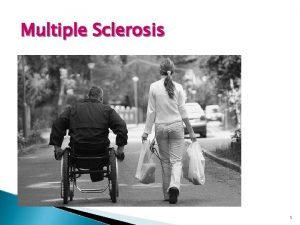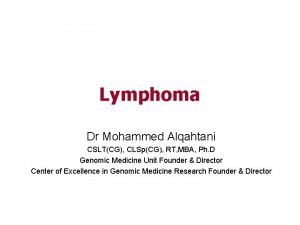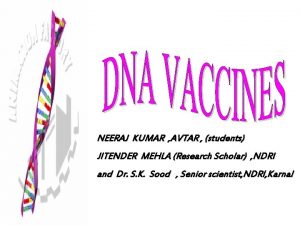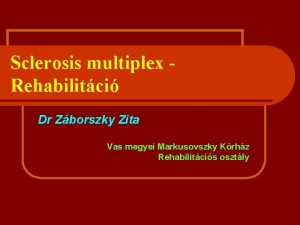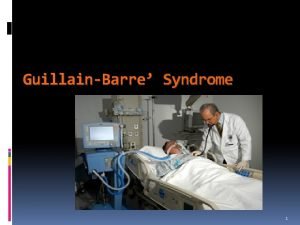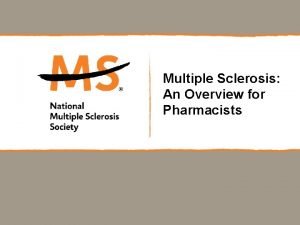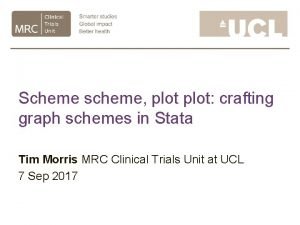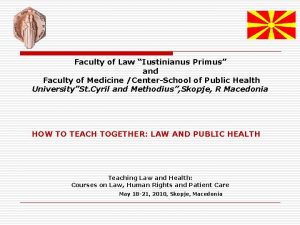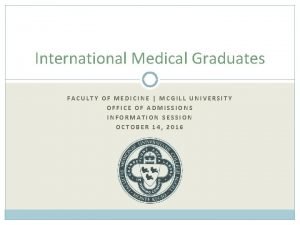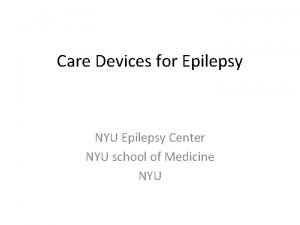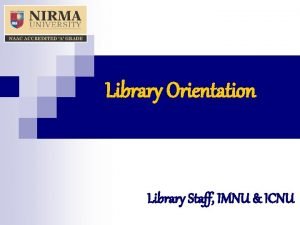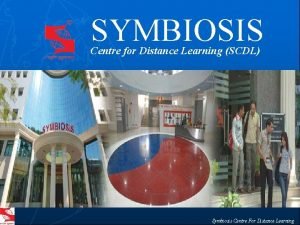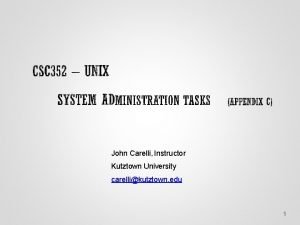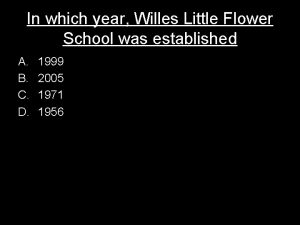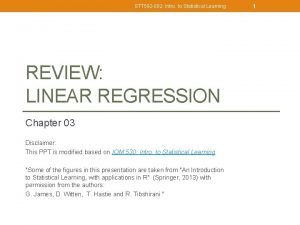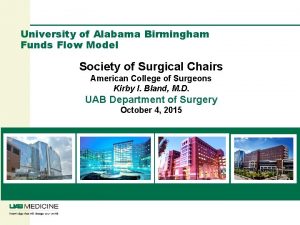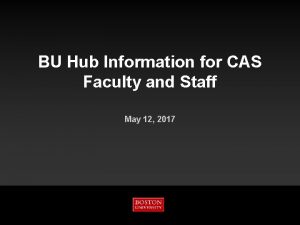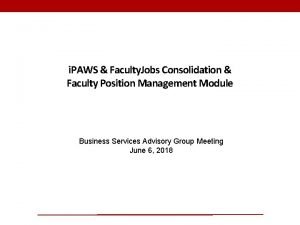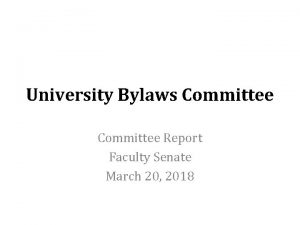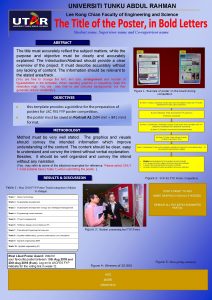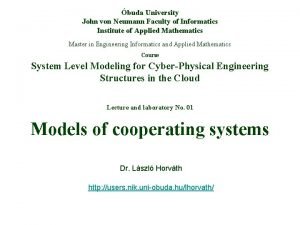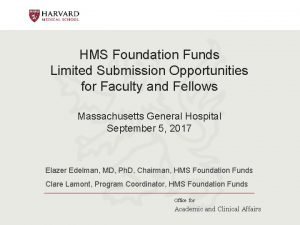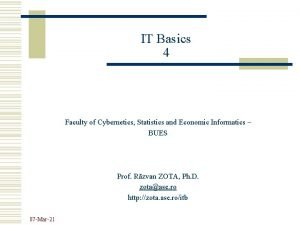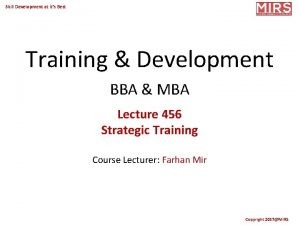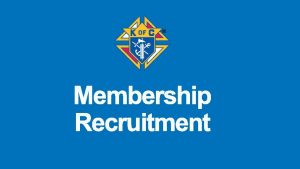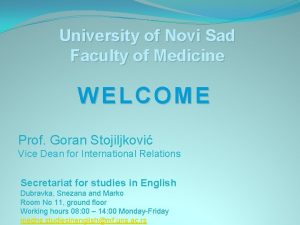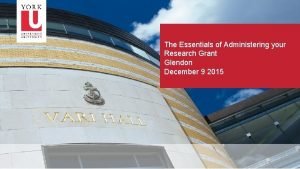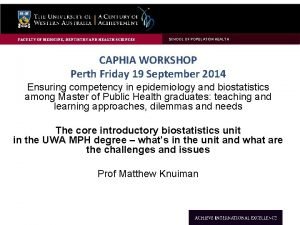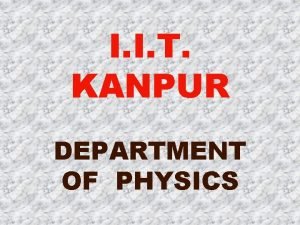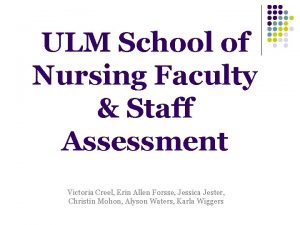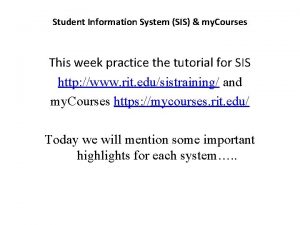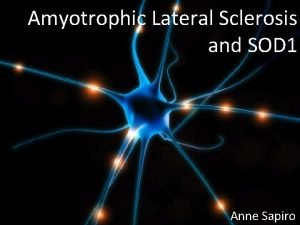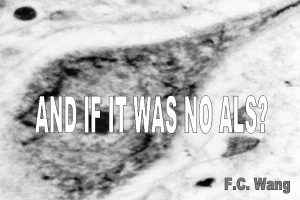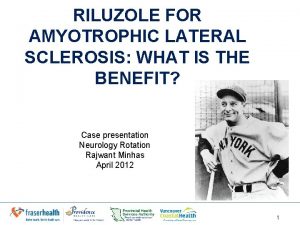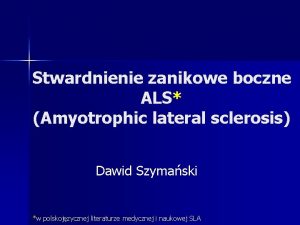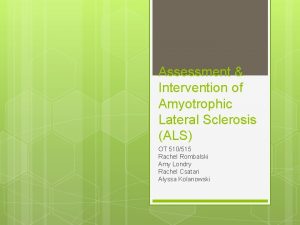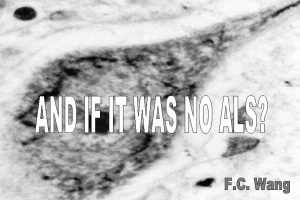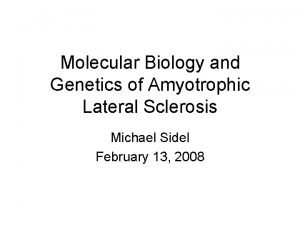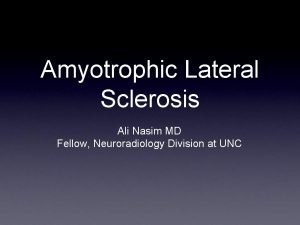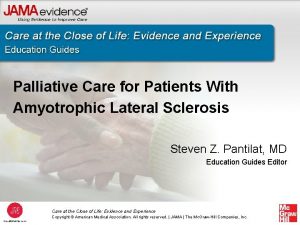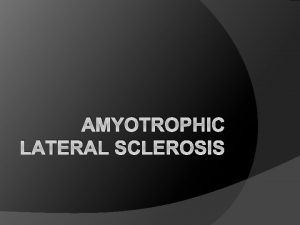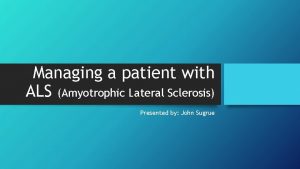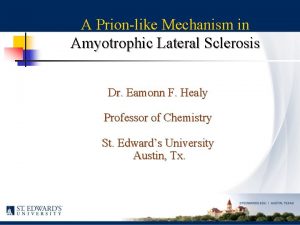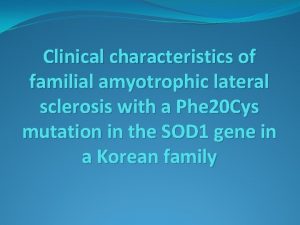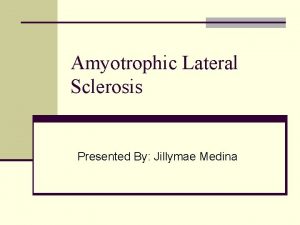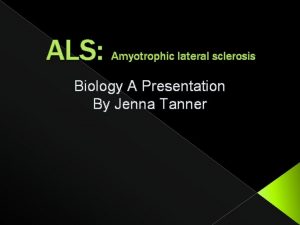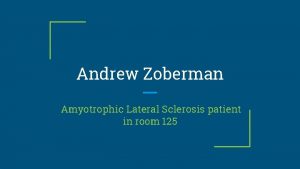Amyotrophic Lateral Sclerosis Faculty Dr C Rathore Scheme



































































































- Slides: 99

Amyotrophic Lateral Sclerosis Faculty : Dr. C. Rathore

Scheme of presentation • Introduction • Etio-pathogenesis • Clinical features • Management

Amyotrophic lateral sclerosis (ALS) • progressive neurodegenerative disease • characterized by loss of motor neurons in – motor cortex – brain stem – spinal cord • dramatically reduces life expectancy

Jean-Martin Charcot • first described ALS in scientific literature. • 1869 • SLA (sclérose latérale amyotrophique), – term is preferred in France Jean-Martin Charcot

“ALS”O known as…. . Sir William Gowers United Kingdom • Believed that ALS patients have pathology of both UMNs and LMNs • MND instead of ALS Lou Gehrig’s disease United States - 1939

Epidemiology • Most frequent adult-onset motor neuron disorder. • Onset - 5 th or 6 th decade • More frequent in men than women (1. 6 : 1)

• Prevalence – 3 -5/100 000. • Incidence – 2 per 100 000 per year. – In younger patients - 1 -3/500 000 / year.

• Pockets of high incidence (50 times more) – Gaum – New guinea – Kii peninsula in Japan.

Sporadic > Inherited ALS Sporadic 90 – 95 % Familial 5 – 10 % Clinically, FALS and SALS are similar.


Etiopathogenesis • Unknown • Multifactorial • Large spectrum of etiological factors • Pathogenic mechanisms – largely unclear and many.

Defective axonal transport Mitochondrial damage Oxidative stress Autoimmune Glial cell pathology Environmental factors Aberrant DNA and RNA metabolism Glutamate toxicity Genetic Viral infections ALS Heavy metal toxicity

Genetic factors • Identification of genes causing FALS has been instrumental in understanding the pathogenesis of ALS. • Discovery of SOD 1 gene mutation in FALS - 1993 • Important step toward finding the causes of ALS

ØCausative genes have been identified in almost 5 -10% of all f. ALS cases • > 30 % - C 9 ORF 72 mutations • 20% - SOD 1 gene • 4 -5% - TARDBP and FUS genes • Rest • Alsin, Senataxin (SETX), Spatacsin, VAPB, Angiogenin (ANG) • Factor induced gene 4 (FIG 4), Optineurin • Perhaps other unknown genes

Genes implicated in pathogenesis

Pathways implicated in motor neuron cell death in ALS

Genetics of ALS

Genetics of slowly progressive ALS

Genetics of ALS with FTD

Genetics of s. ALS

Excitotoxicity One of the most accepted pathogenetic mechanisms of neuronal pathology in ALS.

Excitotoxicity • Glutamate-induced excitotoxicity – Acute neurological conditions and chronic neurodegeneration. – ALS - higher levels of glutamate in the serum and CSF. – High glutamate-induced calcium influx in combination with a low calcium buffering capacity. • Excitotoxicity indicates the disrupted role of surrounding nonneuronal cells in ALS

Environmental • Exposure to toxic agents • Beta-n-Methyl. Amino-l. Alanine (BMAA) – Cyanobacterial neurotoxin, – one of the dietary compounds found in the seed of the cycad – Guamanian ALS

Environmental • Smoking – Active smokers face approximately double risk of developing ALS compared to people who never smoked. – Former smokers face an intermediate risk.

Autoimmune mechanisms

Autoimmune mechanisms Favouring • Auto-antibodies against cellular proteins of the spinal cord has been found in CSF of ALS patients. – Eg: -Against High mobility group box 1 protein • Modest T-cell infiltration in affected areas. • An autoimmune model of ALS has been produced by the inoculation of guinea pigs with purified bovine motor neurons or spinal cord homogenate. Refuting • Trials that have tested autoimmune therapies have not had any effect on the progression of typical ALS. • direct evidence of specific antibodies or T-cell clones attacking motor neurons has not been found • This lack of direct evidence weakens the autoimmune hypothesis

Inflammation

Inflammation • Produces reactive oxygen species in enormous quantities – oxidative sress. • ROS – causes protein dysfuntion impairing axonal transport. • 4 -Hydroxynonenal – byproduct of lipid peroxidation – Bind to a glial glutamate transporter and to impair glutamate transport – Impairs mitochondrial function

Inflammation High COX-2 levels in ALS spinal cords were not observed in unaffected areas of ALS brain or in peripheral organs, indicating a restriction to pathologically affected tissue

Inflammation • Most practical target for anti-inflammatory therapy is COX-2.

Mitochondria - ALS q Involved in the pathogenesis of ALS, principally through • Mitochondrial dysfunction – Energy failure – Generation of ROS – Impaired calcium handling • Altered mitochondrial morphology – defective axonal transport of mitochondria in ALS


Histopathology – Bunina Bodies • Pathognomonic feature of ALS • Tat’yana Bunina, a neuropathologist from the USSR. • She initially believed that they were a virus.

Histopathology • Golgi complex is implicated in the formation of BBs • May be related to nucleic acid dysmetabolism at the r. ER.

Histopathology • Identified in the cytoplasm and dendrites, but not within the axoplasm • With H&E staining, appear as bright pink, oval eosinophilic inclusions, occasionally showing clear areas in the centre and forming clusters • most commonly found in the motor neurons of the spinal cord and in the brainstem nuclei

Clinical features • Clinical picture of ALS is a stereotypical one, resulting from combination of signs, secondary to dysfunction of both UMN and LMN. • Objective sensory findings are incompatible with a diagnosis of amyotrophic lateral sclerosis. • Inexorably progressive – 50% of patients dying within 3 years of onset.

Clinical features LMN Features • Weakness • Wasting and atrophy of muscles • Fasciculations • Cramping • Bulbar symptoms – Slurring Dysarthria – Dysphagia – Chewing difficulty UMN Features • • Spasticity > weakness Pseudobulbar affect Exaggerated DTR Spastic dysarthria

Clinical heterogenicity Ø Recognized feature of the disease Ø Due to • Age of onset • Variable mix of UMN and LMN signs • Site of onset • Survival • Association with other conditions

Clinical heterogenicity Ø Age of onset • Mean age of disease onset is about 65 years. • Young-onset ALS – onset in the third to fourth decade – predominant UMN signs – male prevalence – Less common bulbar onset – more prolonged survival

Clinical heterogenicity Ø Age of onset • Juvenile ALS – Rare – Onset - first two decades – Relatively benign course – familial in majority of cases

Clinical heterogenicity Ø Variable mix of UMN and LMN signs • major contributor to phenotypical heterogeneity of ALS

Clinical heterogenicity Classic ALS (Charcot type) • most frequent form • predominant LMN signs combined with slight to moderate pyramidal signs. Ø Ø Upper motor neuron-dominant (UMN-D) ALS • dominated by pyramidal signs, consisting mainly of severe spinobulbar spasticity, associated with slight LMN signs.

Clinical heterogenicity Ø Progressive muscular atrophy (PMA) • Pure LMN signs without any accompanying clinical or electrophysiological UMN signs. Ø primary lateral sclerosis (PLS) • About 2– 5% of patients with motor neuron disease • exclusive involvement of UMNs with predominant spino-bulbar spasticity

Clinical heterogenicity Ø Site of onset • consistent feature of ALS is that it starts as a focal process involving variable regions in the neuraxis and then spreads through all the motor system

Clinical heterogenicity Ø Site of onset • Bulbar onset ALS. • Spinal onset ALS. • Pseudoneuritic form. • Flail arm syndrome. • Mill’s hemiparetic type.

Clinical heterogenicity Ø Bulbar onset ALS. • present with dysarthria and dysphagia • limbs symptoms occur simultaneously with bulbar symptoms or can occur within 1– 2 years. • Frequent in females • Worse prognosis with respect to the spinal onset form

Clinical heterogenicity Ø Flail arm form • symmetric, predominantly proximal, wasting and weakness of both arms • Relative sparing of lower limbs. • Males • > 40 years of age • better clinical course with respect to classic ALS

Clinical heterogenicity Ø Survival • Median survival of ALS is approximately 3 years after the onset. • Varies widely ranging from few months to over 10 years. • Disease duration depends on the timing of involvement of respiratory muscles. Ø Major negative prognostic factors • older age • bulbar onset Ø The UMN-D phenotype appears to be a strong independent predictor of long survival

Clinical heterogenicity Ø Association with other conditions Ø ALS/FTD • Cognitive abnormalities ranges from impaired frontal executive dysfunction to overt fronto-temporal dementia. • Both ALS and FTD • show neuronal inclusions positive for the TDP-43 • share many gene defects – C 9 ORF 72 – TARDBP – FUS – VCP

Clinical heterogenicity Ø Association with other conditions Ø Association of ALS with Parkinson disease. – Share gene defects • • TARDBP ATXN 2 C 9 ORF 72 ANG

Differential diagnosis • ‘Mimic syndromes’ – absence of disease progression – the presence of an atypical history – Presence of unusual symptoms • two conditions most commonly mistaken for ALS – Multifocal motor neuropathy with conduction block – Cervical spondylotic myelopathy


Diagnostic criteria

Revised El Escorial Criteria

Revised El Escorial Criteria (EEC) • Gold standard of ALS diagnosis. • Very specific • Insensitive and not suitable for early diagnosis. • Therefore the Awaji Criteria have been developed – more emphasis on EMG findings, especially on fasciculation potentials. – Regard fasciculation potentials as sign of active denervation in an otherwise typical clinical context of ALS. • Recent publications confirm that the Awaji Criteria have a higher sensitivity than the EEC in the diagnosis of ALS without increasing the rate of false positive diagnoses

Revised El Escorial Criteria (EEC) Awaji modification of EEC

Awaji criteria


Electrodiagnostic studies • Nerve conduction studies. – Motor and sensory studies. – To rule out mimic syndromes – Normal in ALS.

Electrodiagnostic studies • Electromyography – Most critical ancillary tool in the investigation of ALS. – identify loss of lower motor neurons, the hallmark of ALS – useful in clinically unaffected regions

Electrodiagnostic studies • Electromyography – Most frequently recognized abnormalities • spontaneous denervation discharges (fibrillation potentials and positive sharp waves) indicative of ongoing motor neuron loss, • Fasciculation. • Polyphasic units indicative of reinnervation.

Neuroimaging studies • MRI of the brain and spinal cord – most useful neuroimaging technique in ALS – exclude syndromes that mimic ALS. • T 2 W, FLAIR - Rounded foci of hyperintensity along the corticospinal • not specific for ALS • correlate poorly with both disease severity and the presence of upper motor neuron signs

Genetic testing • Little clinical utility. – Known mutations have limited penetrance – Risk of disease development in an asymptomatic carrier cannot be determined.

Functional disability Quality of life ALS Functional Rating Scale Amyotrophic Lateral Sclerosis Assessment Questionnaire (ALSAQ 40) • Used to monitor functional change in a patient over time. • Measures: • Dependent on factors other than physical functioning. 1. 2. 3. 4. 5. 6. 7. 8. 9. 10. Speech Salivation Swallowing Handwriting Cutting food and handling utensils Dressing and hygiene Turning in bed and adjusting bed clothes Walking Climbing stairs Breathing – Psychological factors – Existential factors (perception of purpose, meaning in life, capacity for personal growth) – Support factors • Does not necessarily deteriorate, despite progressing disability (as assessed by ALS functional rating scale)

Management • No cure yet for ALS. • While research continues, the objective of clinical care is to maintain quality of life and prolonging life as much as possible.

Treatment Multidisciplinary team approach

Putative disease-modifying treatments

Riluzole • Despite over 30 phase II and phase III clinical trials of promising agents , riluzole remains the only evidence-based disease-modifying drug for ALS.


• Riluzole 100 mg daily • Probably prolongs median survival 2 – 3 months in patients with probable and definite ALS with – symptoms less than five years – age less than 75 years – forced vital capacity greater than 60% • More studies are needed, especially to determine whether patients treated earlier or older, more advanced patients with longstanding disease derive the same benefit. • The most frequent side effects are nausea and asthenia. • Liver function becomes altered and requires monitoring.

Supportive and Symptomatic treatment • • • Respiratory function Handling secretions Nutrition Fasciculations, cramps and fatigue Psychiatric disorders Physical rehabilitative measures

Respiratory function • Respiratory failure – Major (60 %) cause of death in patients with ALS – Respiratory muscle weakness - independent predictor of quality of life. • Early symptoms of respiratory dysfunction should be actively sought at each clinic visit

Symptoms of respiratory dysfunction • • • Dyspnea Orthopnea Sleep fragmentation Daytime fatigue Morning headaches Forceless cough

Assessment of respiratory function History & Physical examination Overnight pulse oximetry Vital capacity Maximal inspiratory and expiratory pressures (MIP and MEP) – correlate with respiratory muscle weakness – MIP of <60 cm H 2 O is a predictor of reduced survival • Sniff nasal inspiratory pressure (SNIP) – noninvasive measure of inspiratory force – estimates intrathoracic pressure – sensitive to respiratory muscle weakness – Declines predictably over time predicts survival • •

Criteria for initiation of respiratory support in ALS patients symptoms related to respiratory failure associated with one of the following objective criteria 1. Pa. CO 2 greater than 45 mm Hg and / or 2. Vital capacity less than 50% of normal and / or 3. Nasal inspiratory pressure and maximum pressure sniff below 60% of normal and /or 4. Nocturnal desaturation below 90% Pa. O 2 more than 5% of the time

Respiratory support in ALS patients • Noninvasive positive pressure ventilation (NIPPV) – extends survival, particularly in patients who are able to use it for 5 h or more per day, and those without severe bulbar dysfunction. – Improves patients’ quality of life without increasing caregiver burden or stress. – Overnight pulse oximetry reviewed at regular intervals to ensure that pressure settings are optimized. • Diaphragm Pacing

Handling the secretions • Tenacious secretions – – Adequate hydration Mucolytics Acetylcysteine Saline or bronchodilators nebulisation • Excessive secretions – – – Amitriptyline Hyoscine Scopolamine Botulinum toxin Salivary gland irridiation

Nutrition and gastrostomy • Weight loss – The end result of • Accentuated muscle turnover – Reduced lean body mass – Less physical activity. • Negative calorie balance – Bulbar muscle weakness and dysphagia, – Arm weakness that limits the ability to lift the arm to carry food to the mouth – Hypermetabolism – accelerated clinical deterioration – The rate of weight loss may be a more important predictor of disease progression – Monitoring weight in the clinic is the simplest way to assess caloric balance

Nutrition and gastrostomy Ø Recommendations vary according to symptom severity: • Mild dysphagia – Adaptations in food texture – Postural changes - the chin tuck. • Positive caloric balance , no longer possible orally – gastrostomy is indicated

Nutrition and gastrostomy • Safer while the vital capacity is above 50% of predicted • improves nutrition.

Adjuvant treatment Fasciculations and muscle cramps Fatigue • Mild • Amantadine – Magnesium 5 mmol up to three times a day – Vitamin E 400 IE twice a day • Severe – Quinine sulphate 200 mg twice a day – Carbamazepine 200 mg twice a day – Phenytoin 100 mg up to three times a day • Bupropion • Fluoxetine • Pemoline • Pyridostigmine • Venlafaxine

Spasticity • Baclofen 10– 80 mg • Tizanidine 6– 24 mg • Tetrazepam 100– 200 mg Cramps • Diazepam 2 -10 mg tid • Phenytoin 100 -300 mg qhs • Vitamin E 400 IU tid

Psychiatric disorders Depression • Mirtazapine 15 -30 mg qhs • SSRI antidepressants 20100 mg qd • Tricyclic antidepressants 12. 5 -150 mg qhs • Venlafaxine 37. 5 -75 mg qd Anxiety • Amitriptyline 12. 5 -125 mg qhs • Mirtazapine 15 -30 mg qhs • Buspirone 10 mg tid • Diazepam 2 -10 mg tid • Lorazepam 0. 5 -2 mg tid • Mirtazapine 15 -30 mg qhs

Pathological laughing or crying • Amitriptyline • Fluvoxamine • Lithium carbonate • Levodopa • Dextromethorphan/quinidine

Brain Computer Interface • Useful when some patients become completely locked in, unable to move any voluntary muscle. – anarthria – motor function of limbs is lost. – eye movement is no longer possible.

Brain Computer Interface • provide patients with a device that does not rely on muscle activity. • Patients can learn to spell using a virtual keyboard and to move virtual limbs.

To conclude………. . • Although there has been substantial progress in our understanding of the disorder in the past 25 years, we are still some distance from fulfilling the aim of the Motor Neurone Disease Association to achieve a “World Free of ALS”.

• To quote words of Winston Churchill: “This is not the end. It is not even the beginning of the end. But it is, perhaps, the end of the beginning. ”

Thank you!!

References 1. Ewa Naganska, Ewa Matyja, Amyotrophic lateral sclerosis–looking for pathogenesis and effectivetherapy; Folia Neuropathol 2011; 49 (1): 1 -13 2. Christopher g. Goetz, Amyotrophic lateral sclerosis: early contributions of Jean-Martin charcot; Muscle Nerve 23: 336– 343, 2000. 3. Cedarbaum JM Stambler N. Performance of the Amyotrophic Lateral Sclerosis Functional Rating Scale (ALSFRS) in multicenter clinical trials. J Neurological Sciences. 1997; 152 (Suppl 1): S 1 – S 9.

4. J D Mitchell, G D Borasio , Amyotrophic lateral sclerosis; Seminar, www. thelancet. com Vol 369 June 16, 2007. 5. Crispin Jenkinson et. al, The amyotrophic lateral sclerosis assessment questionnaire (ALSAQ 40): tests of data quality, score reliability and response rate in a survey of patients; Jour Neur Sci 180 (2000) 94– 100. 6. S. T. Y. Ugradar et. al. Bunina bodies; Grand Rounds Vol 10 pages L 6–L 9

7. Peter M. Andersen et. al : Clinical genetics of amyotrophic lateral sclerosis: what do we really know? ; Nat. Rev. Neurol. 7, 603– 615 (2011) 8. Orla Hardiman et. al: Clinical diagnosis and management of amyotrophic lateral sclerosis; Nat. Rev. Neurol. 7, 639– 649 (2011) 9. Anuradha Duleep, MD et. al. Electrodiagnosis of Motor Neuron Disease; Phys Med Rehabil Clin N Am 24 (2013) 139– 151

10. Collette k. Hand et. al: Familial amyotrophic lateral sclerosis; Muscle Nerve 25: 135– 159, 2002. 11. J. C. Schymick et. al: Genetics of sporadic amyotrophic lateral sclerosis; Human Molecular Genetics, 2007, Vol. 16, Review Issue 2 12. Sheng Chen et. al: Genetics of amyotrophic lateral sclerosis: an update; Molecular Neurodegeneration 2013, 8: 28

13. P. L. Mcgeer et. al: Inflammatory processes in amyotrophic lateral sclerosis; Muscle Nerve 26: 459– 470, 2002. 14. L. M. Duffy et. al: Review: The role of mitochondria in the pathogenesis of amyotrophic lateral sclerosis; Neuropath and Applied Neurobiology(2011), 37, 336– 352. 15. Paul H. Gordon et. al: Amyotrophic Lateral Sclerosis: An update for 2013 Clinical Features, Pathophysiology, Management and Therapeutic Trials; Aging and Disease • Volume 4, Number 5, October 2013

16. Miller RG, Mitchell JD et. al: Riluzole for amyotrophic lateral sclerosis (ALS)/motor neurondisease (MND) (Review); Cochr Data. of Syst Rev 2007, Issue 1.


1. Which of the following gene mutation is associated with rapidly progressive FALS ? A. Ubiquilin 2 B. SOD 1 C. TDP 43 D. FIG 4

2. Which of the following is the only gene associated with X-linked dominant inheritance in FALS? A. Ubiquilin 2 B. SOD 1 C. TDP 43 D. FIG 4

3. Which of the following factors are responsible for the selective motor neuron degeneration in ALS? A. Calcium binding protein deficiency B. High energy requirement C. High neurofilament content D. All of the above
 Multiple sclerosis nursing concept map
Multiple sclerosis nursing concept map Hodgkin lymphoma nodular sclerosis
Hodgkin lymphoma nodular sclerosis Virus multiple sclerosis
Virus multiple sclerosis Dr záborszky zita
Dr záborszky zita Multiple sclerosis concept map
Multiple sclerosis concept map Is multiple sclerosis fatal
Is multiple sclerosis fatal Crest syndrom
Crest syndrom Total surface area of a rectangular prism
Total surface area of a rectangular prism Scheme stata
Scheme stata Pyramid scheme vs ponzi
Pyramid scheme vs ponzi 3 domain scheme and 5 kingdom scheme
3 domain scheme and 5 kingdom scheme Faculty of law iustinianus primus
Faculty of law iustinianus primus Department of medicine mcgill
Department of medicine mcgill Hubert kairuki memorial university faculty of medicine
Hubert kairuki memorial university faculty of medicine Ksu.edu.tw
Ksu.edu.tw Webkredit cuni
Webkredit cuni Kfupm faculty housing pictures
Kfupm faculty housing pictures Epilepsy center nyu
Epilepsy center nyu Spletna učilnica fe
Spletna učilnica fe Feinberg faculty portal
Feinberg faculty portal Faculty of electrical engineering
Faculty of electrical engineering Usi faculty
Usi faculty Sjsu faculty affairs
Sjsu faculty affairs Umd ece faculty
Umd ece faculty Advice for new faculty members
Advice for new faculty members Faculty of civil engineering ctu prague
Faculty of civil engineering ctu prague University of kragujevac faculty of technical sciences
University of kragujevac faculty of technical sciences B'faculty of humanities agh', b'poland'
B'faculty of humanities agh', b'poland' Mercy college adjunct positions
Mercy college adjunct positions Electrical engineering kfupm
Electrical engineering kfupm Cairo university faculty of veterinary medicine
Cairo university faculty of veterinary medicine Susilo business center
Susilo business center Semmelweis university faculty of medicine
Semmelweis university faculty of medicine Icnu
Icnu Fulbright faculty development program
Fulbright faculty development program Exam queries scdl
Exam queries scdl Faculty of business and economics mendel university in brno
Faculty of business and economics mendel university in brno Agnes csaki semmelweis
Agnes csaki semmelweis Hacettepe university faculty of medicine
Hacettepe university faculty of medicine Bridgeport university computer science
Bridgeport university computer science Faculty of education
Faculty of education Faculty of law maastricht
Faculty of law maastricht The faculty of observing in any given case
The faculty of observing in any given case Leading university location
Leading university location Clemson electrical engineering
Clemson electrical engineering Faculty of law of the university of zagreb
Faculty of law of the university of zagreb Feedback for faculty development programme
Feedback for faculty development programme Carelli
Carelli Electrotechnical faculty belgrade
Electrotechnical faculty belgrade University of pecs faculty of health sciences
University of pecs faculty of health sciences Willes little flower school chairman
Willes little flower school chairman 002
002 Uab comp clinic
Uab comp clinic Ascaris lumbricoides ova
Ascaris lumbricoides ova Bu hub units
Bu hub units Hijjawi faculty for engineering technology
Hijjawi faculty for engineering technology Chronicle salary data
Chronicle salary data Faculty of economics and business zagreb
Faculty of economics and business zagreb Ugajobs
Ugajobs Unlv faculty senate
Unlv faculty senate University of cologne faculty of management
University of cologne faculty of management Factors influencing faculty staff relationship
Factors influencing faculty staff relationship Lee kong chian faculty of engineering and science
Lee kong chian faculty of engineering and science Ecu faculty 180
Ecu faculty 180 John von neumann faculty of informatics
John von neumann faculty of informatics Faculty model of training
Faculty model of training York university concurrent education
York university concurrent education Mrbs scholarship
Mrbs scholarship Hms foundation funds
Hms foundation funds The faculty
The faculty Hahnville high school powerschool
Hahnville high school powerschool Cybernetics statistics and economic informatics
Cybernetics statistics and economic informatics Faculty of engineering university of porto
Faculty of engineering university of porto Wpi computer science flowchart
Wpi computer science flowchart Faculty model of training
Faculty model of training Vibrant faculty recruitment
Vibrant faculty recruitment Faculty kutztown carelli
Faculty kutztown carelli University management system dbms project
University management system dbms project Alamo colleges salary schedule
Alamo colleges salary schedule Licension
Licension Medical faculty in novi sad dean
Medical faculty in novi sad dean Utar faculty
Utar faculty Faculty of veterinary medicine cairo university
Faculty of veterinary medicine cairo university University of montenegro faculty of law
University of montenegro faculty of law Computer science fsu
Computer science fsu Elearningunideb
Elearningunideb Faculty of education khon kaen university
Faculty of education khon kaen university Faculty model of training
Faculty model of training Fsu new faculty orientation
Fsu new faculty orientation Solid thyroid nodule
Solid thyroid nodule Glendon faculty council
Glendon faculty council Faculty model of training
Faculty model of training Brown university computer science
Brown university computer science Uci upath
Uci upath Faculty of medicine dentistry and health sciences
Faculty of medicine dentistry and health sciences Fitsac
Fitsac Iit kanpur physics faculty
Iit kanpur physics faculty Ulm nursing faculty
Ulm nursing faculty Sis rit edu
Sis rit edu Herszon kherson maritime college of merchant marine fleet
Herszon kherson maritime college of merchant marine fleet
